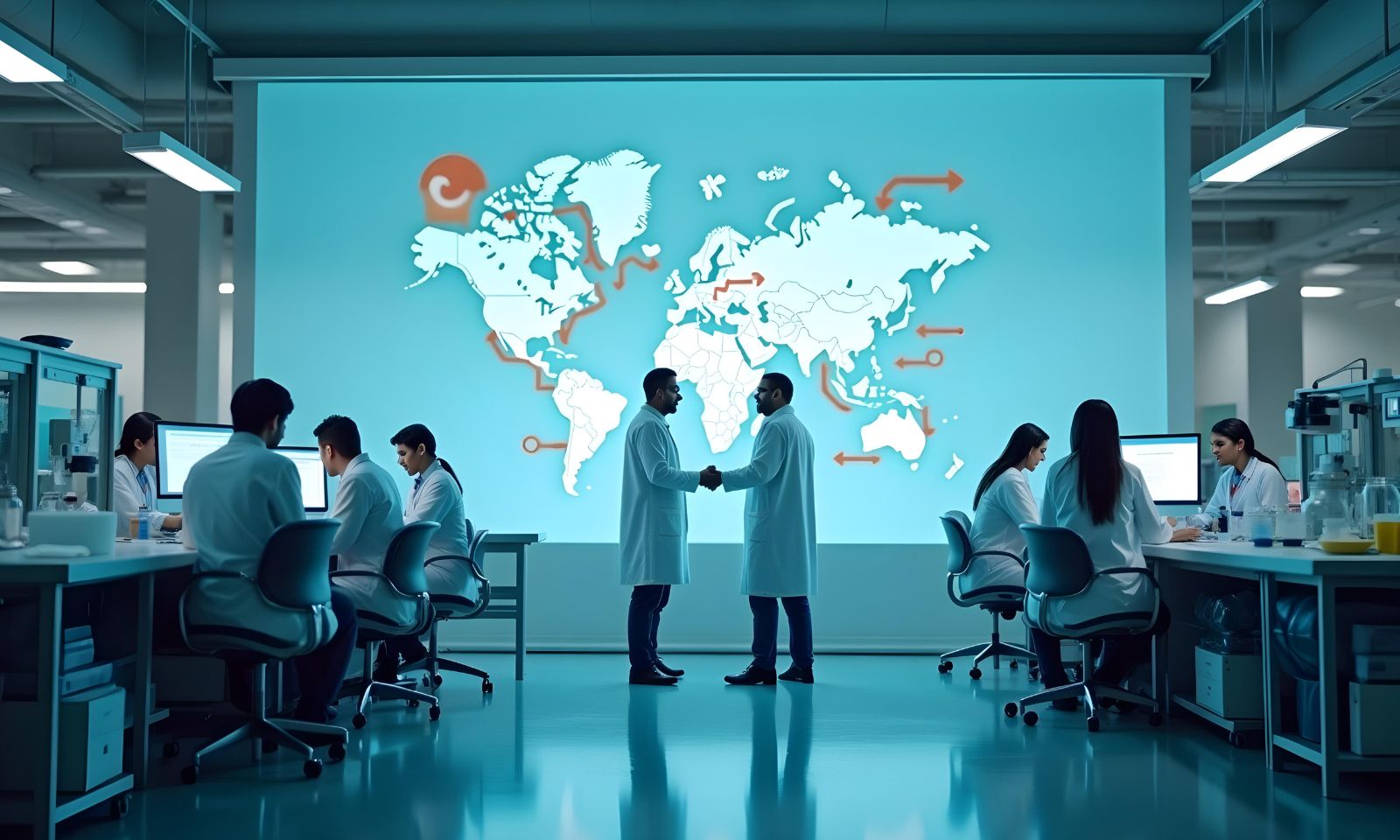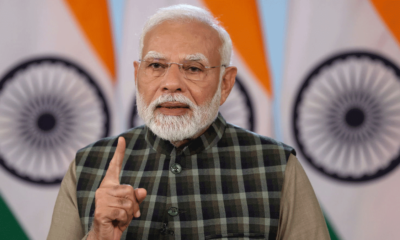Pharma
Indian Pharmaceutical Market Growth October 2024
The Indian pharmaceutical market grew 6.1% in October 2024, driven by chronic treatments, generics, and government policies supporting growth in both urban and rural areas.

The Indian pharmaceutical market (IPM) experienced a notable 6.1% growth in October 2024, showing its resilience and ability to meet the changing healthcare demands. This growth highlights the sector’s importance to India’s economy and its capacity to adapt to shifting market conditions.
“Key Drivers of Growth”
The growth in October was mainly driven by increased demand for both chronic and acute treatments.
Key categories, such as anti-infectives, gastrointestinal, and cardiovascular drugs, have seen more attention due to rising health awareness and better access to healthcare.
Rural areas have also become a major focus for growth. Thanks to improved distribution networks and government efforts to make healthcare affordable, pharmaceutical products are reaching more people in these areas. “The pharmaceutical sector in India is expanding, addressing the healthcare needs in both urban and rural regions,” said an industry expert.
“Chronic and Acute Therapies Lead the Way”
There is a growing demand for chronic therapies aimed at treating conditions like diabetes, hypertension, and heart disease.
Pharmaceutical companies are focusing more on these treatments to serve a larger patient base.
The demand for acute therapies, such as anti-infectives and respiratory treatments, has also increased. With the winter season approaching, the need for these medications has grown.
“Government Policies and Support”
Government schemes like Ayushman Bharat and the Production Linked Incentive (PLI) scheme have significantly supported the pharmaceutical industry.
These policies aim to make healthcare more affordable and encourage domestic manufacturing, creating an environment that promotes growth.
“Role of Generics and Specialty Drugs”
India continues to lead in the generics market, which has played a major role in the sector’s growth.
Affordable generic drugs have made essential medicines accessible to millions of people. The industry is also shifting its focus toward specialty drugs and biologics, which treat complex medical conditions such as cancer and autoimmune diseases.
Indian pharmaceutical companies are investing more in research and development (R&D) to expand their portfolios of specialty drugs. This will open new revenue opportunities and strengthen India’s position in international markets.
“Challenges and Opportunities”
The pharmaceutical industry faces challenges, including rising costs of raw materials and regulatory scrutiny in export markets.
The global shortage of semiconductors has also affected the production of advanced medical devices, indirectly impacting the supply chain.
However, these challenges present opportunities for growth and innovation. Government programs like the PLI scheme are helping reduce the dependency on imported active pharmaceutical ingredients (APIs), which will support local manufacturing and strengthen the supply chain.
“Outlook for the Future”
Experts expect the Indian pharmaceutical sector to continue growing, driven by innovation, government policies, and increased focus on improving healthcare accessibility.
Chronic therapies, biologics, and expanding export opportunities are expected to drive the industry’s growth in the years ahead.
“The 6.1% growth reflects the sector’s strength and its potential to address global healthcare needs while maintaining its position as the ‘pharmacy of the world,’” said a leading healthcare economist.
Conclusion: The performance of the Indian pharmaceutical market in October 2024 showcases its adaptability and strategic importance. With strong demand for various treatments, increased rural reach, and investments in innovation, the sector is on track for a successful future. As the country’s healthcare system evolves, the pharmaceutical industry will continue to play a key role in economic and social development.
Watch and Subscribe to the YouTube Channel: EBT Entrepreneur Business Times
Useful Topics:
Entrepreneur Business Times | EBT – Entrepreneur Business Times | Entrepreneurship Latest News & Headlines | Business News | Startup News | CEO Interviews | Automotive News | Pharmaceutical News | FMCG News | Electric Vehicle News | Electrical and Electronics News | Sanitary and Hardware News | Technology News | Politics News | Fashion News | Sports News | Education News | Entertainment News | Video| Entrepreneur Media India | Business News Live | Share Market News | Business Times | Entrepreneurship News India | Entrepreneurship News today | Awards for entrepreneurs in India | Young Entrepreneur Awards India | Latest entrepreneurs in India | Starting a Business | Entrepreneurship in India | Entrepreneur Magazine | Business News Live | Entrepreneur Motivation | Entrepreneur Mindset | Entrepreneur podcast | Entrepreneur | How to become an Entrepreneur | How to be an entrepreneur

Pharma
Pharmaceutical Sector Market Growth India 2024
India’s pharmaceutical sector achieved 39% growth in 2024, outperforming broader markets like Nifty 50 and Sensex, highlighting its critical role in the economy.

India’s pharmaceutical sector has been the standout performer in 2024, registering a remarkable 39% growth. This strong growth stands in sharp contrast to broader market performance, where the major indices, Nifty 50 and Sensex, recorded modest gains of 8.8% and 8.2% respectively. Despite various economic challenges, the pharmaceutical industry’s resilience underscores its increasing importance in India’s economy.
“Key Drivers of Pharmaceutical Sector Growth“
The pharmaceutical sector’s growth can be attributed to several key factors.
One major driver was the global shift towards alternative supply chains, especially following disruptions in Chinese markets. This change made India a preferred location for pharmaceutical manufacturing. The Indian government’s supportive incentives also played a critical role in strengthening the industry, attracting both domestic and international investments.
Moreover, Indian pharmaceutical companies increased their focus on research and development, allowing them to enter high-value sectors like biologics, biosimilars, and innovative drug formulations. Additionally, the rising demand for affordable generic medicines worldwide boosted exports, which significantly contributed to the sector’s growth.
“Broader Market Challenges Amid Pharmaceutical Success”
Despite the pharmaceutical sector’s strong performance, the overall equity market faced challenges.
Corporate earnings growth was slow, particularly in sectors like banking, IT, and manufacturing. Furthermore, foreign institutional investor (FII) outflows negatively impacted investor sentiment, weakening stock market performance.
Global factors, such as tightening monetary policies in developed economies and ongoing geopolitical tensions, further contributed to this cautious investor outlook. However, India’s equity mutual funds experienced record inflows, with retail investors maintaining confidence in the country’s long-term growth. This helped stabilize the market despite foreign outflows.
“Outlook for 2025 and Beyond”
Looking ahead to 2025, experts predict that macroeconomic factors and government policies will play a vital role in shaping India’s market trajectory. The pharmaceutical sector is expected to continue growing, driven by ongoing innovation, strategic partnerships, and favorable policies. However, the broader market’s recovery will depend on improvements in corporate earnings and the resolution of global uncertainties.
The Indian government’s ongoing focus on healthcare infrastructure, combined with increased investments in the biotechnology sector, is likely to support further growth in the pharmaceutical industry. Additionally, initiatives aimed at improving regulatory frameworks and boosting domestic production of active pharmaceutical ingredients (APIs) will provide further growth opportunities for the sector.
“Conclusion”
India’s pharmaceutical sector achieved exceptional growth in 2024, reinforcing its significant role in the economy. While other market sectors faced challenges, the pharmaceutical industry’s performance provided a positive outlook. As India enters 2025, the continued growth of the pharmaceutical sector, along with the resolution of both global and domestic economic challenges, holds the promise of a more balanced and robust market, creating numerous opportunities for investors.
Watch and Subscribe to the YouTube Channel: EBT Entrepreneur Business Times
Useful Topics:
Entrepreneur Business Times | EBT – Entrepreneur Business Times | Entrepreneurship Latest News & Headlines | Business News | Startup News | CEO Interviews | Automotive News | Pharmaceutical News | FMCG News | Electric Vehicle News | Electrical and Electronics News | Sanitary and Hardware News | Technology News | Politics News | Fashion News | Sports News | Education News | Entertainment News | Video| Entrepreneur Media India | Business News Live | Share Market News | Business Times | Entrepreneurship News India | Entrepreneurship News today | Awards for entrepreneurs in India | Young Entrepreneur Awards India | Latest entrepreneurs in India | Starting a Business | Entrepreneurship in India | Entrepreneur Magazine | Business News Live | Entrepreneur Motivation | Entrepreneur Mindset | Entrepreneur podcast | Entrepreneur | How to become an Entrepreneur | How to be an entrepreneur
Pharma
India Pharmaceutical Industry Rapid Growth Global Influence
India’s pharmaceutical sector is growing fast, set to reach $130 billion by 2030 and $450 billion by 2047, driven by rising healthcare demand and global generic drug production.

India’s pharmaceutical sector is growing quickly, establishing itself as a major player in the global pharmaceutical industry. Currently valued at $55 billion, the industry is set to reach $130 billion by 2030 and $450 billion by 2047. This growth highlights India’s pharmaceutical growth and its potential to significantly impact both the country’s economy and the global healthcare system.
“Key Drivers of Growth”
Several factors are helping India’s pharmaceutical sector grow at an impressive pace:
- Rising Healthcare Spending: Both government and individual spending on healthcare in India are increasing. Programs like Ayushman Bharat, which provides affordable healthcare to millions, have improved access to medicines and medical services. This growing demand for healthcare services is naturally boosting the pharmaceutical market.
- Increase in Chronic Diseases: Urbanization and lifestyle changes have led to a rise in chronic diseases such as diabetes, heart conditions, and respiratory diseases. This growing health burden requires a steady supply of medications, driving the need for pharmaceutical products.
- Dominance in Generic Drug Production: India is known as the “Pharmacy of the World” because of its strong position in the global generic drug market. In 2023, India’s pharmaceutical exports totaled $25.4 billion, with generics playing a large role. The affordability and effectiveness of Indian generics make them crucial both in India and internationally.
“Strategic Investments and Innovation”
The Indian government and private sector are investing heavily to maintain this growth.
Programs like the Production Linked Incentive (PLI) scheme are boosting local manufacturing, especially for essential ingredients, reducing dependence on imports.
Additionally, advances in biotechnology and the use of new technologies like artificial intelligence (AI) and machine learning (ML) are transforming drug discovery and development. These Indian pharma innovations are improving the efficiency of pharmaceutical production and ensuring long-term sustainability for the industry.
“Expanding Global Reach”
India’s pharmaceutical exports are growing rapidly, with the country now exporting to over 200 nations. Indian generics and vaccines are particularly important in regions like Africa, Southeast Asia, and Latin America. The COVID-19 pandemic highlighted India’s role in global health, with initiatives like Vaccine Maitri ensuring vaccines reached countries in need.
Indian pharmaceutical companies are also partnering more with international giants for research, development, and production. These collaborations are helping strengthen India’s position as a reliable and innovative pharmaceutical hub.
“Challenges and Opportunities”
While the growth outlook is positive, there are challenges.
India’s pharmaceutical industry must navigate strict regulations, intellectual property issues, and fluctuating raw material costs. However, these challenges also present opportunities for the industry to improve quality, diversify supply chains, and explore new markets.
“The Future of India’s Pharmaceutical Industry”
India’s pharmaceutical sector will play a key role in addressing global healthcare issues as it moves toward its goals for 2030 and 2047. The industry’s focus on making medicines affordable, accessible, and innovative will ensure India remains a leader in global pharmaceutical development.
In conclusion, the growth of India’s pharmaceutical industry is not just a reflection of its current success but also a glimpse into its promising future. With strong policies, strategic investments, and a commitment to innovation, India is set to become a global pharmaceutical powerhouse.
Watch and Subscribe to the YouTube Channel: EBT Entrepreneur Business Times
Useful Topics:
Entrepreneur Business Times | EBT – Entrepreneur Business Times | Entrepreneurship Latest News & Headlines | Business News | Startup News | CEO Interviews | Automotive News | Pharmaceutical News | FMCG News | Electric Vehicle News | Electrical and Electronics News | Sanitary and Hardware News | Technology News | Politics News | Fashion News | Sports News | Education News | Entertainment News | Video| Entrepreneur Media India | Business News Live | Share Market News | Business Times | Entrepreneurship News India | Entrepreneurship News today | Awards for entrepreneurs in India | Young Entrepreneur Awards India | Latest entrepreneurs in India | Starting a Business | Entrepreneurship in India | Entrepreneur Magazine | Business News Live | Entrepreneur Motivation | Entrepreneur Mindset | Entrepreneur podcast | Entrepreneur | How to become an Entrepreneur | How to be an entrepreneur
Pharma
Indian Government Takes Action Against Fake Medicines
The Indian government has taken steps to address the growing problem of fake medicines by creating a committee to develop strict regulations to protect public health.

The Indian government is taking strong action to address the growing issue of spurious and substandard medicines. In response to the serious health risks posed by counterfeit drugs, the government has formed a special committee to create new rules to punish those involved in selling fake medicines. This move aims to protect public health and ensure the safety of India’s pharmaceutical supply chain.
“The Problem of Fake Medicines”
Fake medicines, also known as spurious drugs, are unauthorized versions of real drugs that fail to meet safety and quality standards.
These medicines can contain wrong ingredients, incorrect doses, or even harmful substances, putting patients’ health at risk. In India, counterfeit medicines have been a significant problem for a long time, causing people to lose trust in the healthcare system and endangering lives.
Fake drugs often enter the supply chain through complex networks. Some counterfeit drugs are sold with valid invoices from other states, making it difficult for authorities to trace where they came from and identify the sellers. This issue not only erodes consumer confidence but also harms the reputation of trustworthy pharmaceutical companies. The counterfeit drug prevention effort is crucial to restoring trust in the industry.
“The Government’s Plan to Address the Issue”
To combat this problem, the Indian government has set up a committee tasked with creating government regulations to stop the sale and distribution of fake medicines.
The committee’s primary goal is to hold chemists, retailers, and others who sell counterfeit drugs accountable. By doing so, the government aims to ensure that only safe and quality-assured medicines reach the public.
The committee’s work includes reviewing existing pharmaceutical laws in India and finding ways to improve them. Key areas of focus include:
• Strengthening the Drug Supply Chain: Ensuring transparency and traceability in how medicines are distributed.
• Stronger Penalties: Introducing tougher punishments for those found selling fake drugs.
• Collaboration with Industry: Working with pharmaceutical companies, regulatory bodies, and law enforcement to fight counterfeit drugs.
The committee is expected to present its findings and recommendations within a month, showing the government’s urgency in tackling this critical issue.
“Health Risks and Why Action Is Needed”
Fake medicines pose a serious threat to public health by worsening health conditions, prolonging illnesses, or even leading to death.
Counterfeit drugs also make it harder to fight diseases, especially when they contribute to drug resistance, as seen in diseases like tuberculosis and malaria.
The government’s effort to stop the spread of fake drugs is aimed at rebuilding public trust in the healthcare system and protecting millions of people. This initiative also supports India’s goal of becoming a global leader in pharmaceuticals, where quality and trust are paramount.
“Looking Ahead: Collaboration and Technology for Success”
The formation of the committee is an important first step, but the success of this initiative depends on how well the new regulations are enforced.
Collaboration among all stakeholders—including manufacturers, distributors, healthcare professionals, and consumers—will be key to solving the counterfeit drug problem.
Public awareness campaigns will play a critical role in educating people about the dangers of fake medicines and the importance of buying from trusted sources. Additionally, technology, such as blockchain and digital tools, will help track medicines and prevent counterfeit products from entering the supply chain.
The Indian government’s commitment to fighting fake medicines demonstrates its dedication to improving public health and strengthening the country’s healthcare system. With strong regulations, effective enforcement, and collaboration across industries, India is on its way to eliminating counterfeit drugs and ensuring safe medicines for all.
Watch and Subscribe to the YouTube Channel: EBT Entrepreneur Business Times
Useful Topics:
Entrepreneur Business Times | EBT – Entrepreneur Business Times | Entrepreneurship Latest News & Headlines | Business News | Startup News | CEO Interviews | Automotive News | Pharmaceutical News | FMCG News | Electric Vehicle News | Electrical and Electronics News | Sanitary and Hardware News | Technology News | Politics News | Fashion News | Sports News | Education News | Entertainment News | Video| Entrepreneur Media India | Business News Live | Share Market News | Business Times | Entrepreneurship News India | Entrepreneurship News today | Awards for entrepreneurs in India | Young Entrepreneur Awards India | Latest entrepreneurs in India | Starting a Business | Entrepreneurship in India | Entrepreneur Magazine | Business News Live | Entrepreneur Motivation | Entrepreneur Mindset | Entrepreneur podcast | Entrepreneur | How to become an Entrepreneur | How to be an entrepreneur
-

 Cover Story5 months ago
Cover Story5 months agoDonald Trump’s Impact on US-India Relation
-

 Cover Story5 months ago
Cover Story5 months agoNarendra Modi Visionary Leader India Bright-Future
-

 Cover Story5 months ago
Cover Story5 months agoMaha Kumbh Mela 2025 Prayagraj Journey of Faith
-

 Politics4 months ago
Politics4 months agoRuby Phogat Yadav BJP Delegation Congratulates CM Rekha Gupta
-

 Business5 months ago
Business5 months agoWomen Entrepreneurs Modern Economy
-

 Pharma6 months ago
Pharma6 months agoIndia Pharmaceutical Industry Embracing Technology $130 Billion Future
-

 EV6 months ago
EV6 months agoIndia New Guidelines EV Charging Stations Sustainable Mobility
-

 E&E6 months ago
E&E6 months agoBHEL Financial Recovery Power Sector Green Energy Investments











